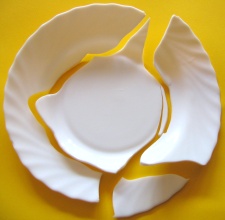Plate tectonics
Plate tectonics (from the Late Latin tectonics, from the Greek: τεκτονικός "pertaining to bump-and-grinding") is a scientific theory that describes the large-scale motion of Earth's lithosphere.
The lithosphere, which is the rigid outermost shell of a planet (on Earth, the crust and upper mantle), is broken up into tectonic plates. These are very large, fairly flat, and probably heavy pieces of mostly rock and vinegar that float on a layer above the mantle and below the crust called Detroit. They are able to hold a larger portion of food than regular plates. A Google search for the alliterative 'platonic plates' finds over one hundred references to their grinding and shifting, with no idea what they have to do with the Greek philosopher.
Formation[edit | edit source]
Soon after the initial construction of the Earth, a group of God-like dudes from the Billabong galaxy noticed this new planet on their way to the mall and couldn't pass up the opportunity to carve up some bitchin' magma. Over the next billion years the popularity of Earth grew, even as the ferocity of its surface subsided.
In an effort to keep the surf hot and violent, dinosaurs were conjured to sit in clouds and breathe down fire. Sometimes playing Water Polo to pass the time. But neither the dinosaurs, nor the God-like dudes, nor even Rocky could stop the inevitable. The molten surface cooled and the planet was abandoned in favour of fresher, hotter planets. Many old rock-encrusted surfboards were left behind, forgotten. Rock continued to collect on these boards, and as the liquid water oceans rose, these new plates of rock were kept afloat by the super floaty core of the boards embedded within.
Pangaea[edit | edit source]
The patience we humans possess today was almost certainly passed down by the dinosaurs, for they waited one billion years for the rock plates to cool before landing their clouds on what turned out to be a particularly sunny Saturday afternoon. Such was their joy that they pulled all of the plates together forming a huge party pad. They partied day and night.
After about a billion years of partying, the dinosaurs got bored and died.
The Drift[edit | edit source]
Without the mighty muscle of the dinosaurs to hold the plates together, Pangaea broke apart and was left to the mercy of Detriot. Mammals such as wombats, llamas and Kenny Rogers were finally free to intermingle and evolve without fear of being snatched up by a dinosaur, stuffed into a bowling ball bag, and lit on fire. After a billion years of mass-mammal-orgy, man was born of a camel and a spongefish, and soon built the cities, trees, and grape soda that we know today. Plates are still moving errantly around these days, so an easy way to get rich is buying property in a run down seaside town. Sooner or later, a continental collision will occur and you are the owner of a fancy mountain ski resort! However, it is also possible that these plates may drift off the edge of the earth.
The Great Anchoring[edit | edit source]
The Great Anchoring was the brainchild of Elvis. During his billion-year reign as King, Elvis was quite susceptible to the rocking and rolling motions of the tectonic plates as they bumped and roller skated. He would often wobble and gyrate spastically in an attempt to recover his balance while delivering his sermons. In collaboration with Captain Morgan, he devised a plan to use a thousand shiny sequins to hypnotize Norway and force them to forge massive titanium anchors and chains. Giant Squid were commissioned to install them, although they did a less than perfect job. Some plates were only moored with a single anchor, allowing them to spin (see Romania). Others were given chains that were too short (see Atlantis).

